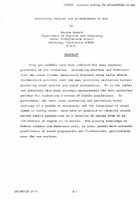| dc.contributor.author | Medwin, Herman | |
| dc.date.accessioned | 2018-10-11T14:09:59Z | |
| dc.date.available | 2018-10-11T14:09:59Z | |
| dc.date.issued | 1975/10 | |
| dc.identifier | 300 | |
| dc.identifier.govdoc | CP-17/2 | |
| dc.identifier.uri | http://hdl.handle.net/20.500.12489/712 | |
| dc.description.abstract | Free gas bubbles have been indicted for many physical processes at sea including: scavenging detritus and chemicals from the ocean volume; generating droplets whose salts affect thunderstorm activity over the sea; providing cavitation nuclei; producing sound scatter and sound attenuation. It is the latter two phenomena that make acoustic measurements the most promising pathway for conducting a census of bubble populations. In particular, the very large scattering and extinction cross sections of a bubble at resonance, and the dispersion of sound speed in bubbly water, have made it possible to recently obtain marine bubble populations as a function of radius from 20 to 300 microns at depths to 15 metres. The~rowing knowledge of bubble numbers and behaviour will, in turn, permit more accurate predictions of sound propagation and fluctuations, particularly near the sea surface. | |
| dc.format | 29 p. : ill. ; digital, PDF file | |
| dc.language | English | |
| dc.publisher | NATO. SACLANTCEN | |
| dc.source | In: Ocean Acoustic Modelling (SACLANTCEN Conference Proceedings CP-17), Part 2, 1975, pp. 6-1 - 6-29. | |
| dc.subject | Bubbles | |
| dc.subject | Gases | |
| dc.subject | Underwater acoustics | |
| dc.subject | Acoustic scattering - Seafloor and sea surface | |
| dc.title | Acoustical probing for microbubbles at sea | |
| dc.type | Papers and Articles | |
| dc.type | Conference Proceedings (CP) | |
